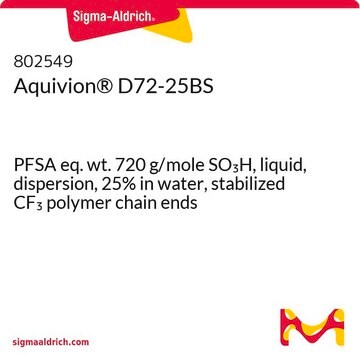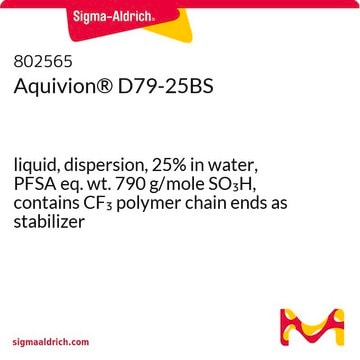565067
Nafion™ perfluorinated membrane
Nafion™ 324, reinforced with poly(tetrafluoroethylene) fiber, thickness 0.006 in.
About This Item
Productos recomendados
eq. wt.
1100 2nd membrane
1500 1st membrane
manufacturer/tradename
Nafion™ 324
greener alternative product characteristics
Design for Energy Efficiency
Learn more about the Principles of Green Chemistry.
sustainability
Greener Alternative Product
L × W
12 in. × 12 in.
thickness
0.006 in.
solubility
H2O: insoluble
greener alternative category
, Enabling
InChI
1S/C7HF13O5S.C2F4/c8-1(9)2(10)24-5(15,16)3(11,4(12,13)14)25-6(17,18)7(19,20)26(21,22)23;3-1(4)2(5)6/h(H,21,22,23);
InChI key
FOYUGSIADQEOEK-UHFFFAOYSA-N
¿Está buscando productos similares? Visita Guía de comparación de productos
General description
Application
Packaging
· Keep pieces sealed and protected from general exposure will reduce the effect. Recommend long term storage in air-tight bags.
· Discoloration does not affect performance and can be removed by soaking in dilute nitric acid.
Legal Information
Storage Class
11 - Combustible Solids
wgk_germany
nwg
flash_point_f
Not applicable
flash_point_c
Not applicable
ppe
Eyeshields, Gloves, type N95 (US)
Certificados de análisis (COA)
Busque Certificados de análisis (COA) introduciendo el número de lote del producto. Los números de lote se encuentran en la etiqueta del producto después de las palabras «Lot» o «Batch»
¿Ya tiene este producto?
Encuentre la documentación para los productos que ha comprado recientemente en la Biblioteca de documentos.
Artículos
Polymer electrolyte membrane (PEM) fuel cells offer high efficiency and low-temperature operation, reducing oil use in light-duty vehicle transportation.
Proton exchange membrane (PEM) fuel cells operate at relatively low temperatures and are composed of two electrodes and a conductive elecrolyte.
Advances in electrochemical water conversion and understanding PEMFC degradation drive progress in hydrogen technologies.
Nuestro equipo de científicos tiene experiencia en todas las áreas de investigación: Ciencias de la vida, Ciencia de los materiales, Síntesis química, Cromatografía, Analítica y muchas otras.
Póngase en contacto con el Servicio técnico







